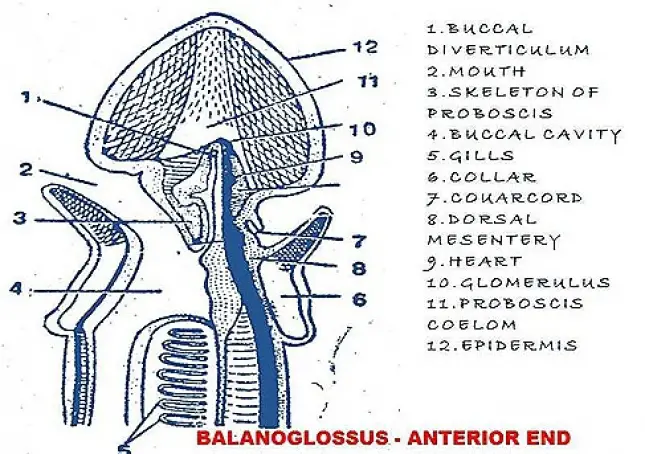Medically reviewed and approved by a board-certified member
Zoology
DIGESTIVE SYSTEM OF BALANOGLOSSUS
By BS MediaTwitter Profile | Published: Monday, 05 June 2017

Balanoglossus is a worm like chordate animal. It is cylindrical organism and lives in burrows of the sand. This animal shows a long alimentary canal and associated glands. This is called digestive system. The alimentary canal starts as mouth and ends with anus.
1. Mouth: It is present on the ventral side of the body between proboscis and collar. It is a permanent pore.
Recent investigations proved that this animal can open or close its mouth.
2. Buccal cavity: Mouth leads into buccal cavity. It is present in the Collar region. This will extend into the proboscis as stomochord.
3. Pharynx: Buccal cavity will lead into pharynx. It is present in the branchio - genital region of the trunk. This can be divisible into dorsal respiratory chamber and ventral food collecting chamber. The food collecting chamber is covered by ciliated glandular epithelium. This part will concentrate the food organisms present in the water that enters into this chamber, in the dorsal respiratory chamber gills are present. They are useful to perform respiration and send out water through the openings of gill on the body wall.
4. Oesophagus: Pharynx will lead into the oesophagus. It is a very smallpart in the alimentary canal.
5. Intestine: It is a long straight tube. It travels all along the trunk and it is divisible into 2 parts
- the first part containing hepatic caecae.
- the second part will not contain hepatic caecae.
6. Anus: At the tip of the trunk the alimentary canal will end as Anus.
Food: The food of Balanoglossus is small micro-organisms and small organic particles present in water.
Feeding: Balanoglossus shows ciliary mode of feeding or it is a niter feeder.
By the movement of cilia of the gills water is brought into the pharynx. The food is collected in the pharynx and pushed into oesophagus and then into intestine. The water is sent out through gills.
Digestion: The glandular cells of the pharynx, intestine will produce digestive juices. The hepatic caecae will also produce digestive juices. They will digest the food in the intestine.
The digested food is absorbed by the blood through intestine wall and is utilized.
Egestion: The undigested food along with sand will be sent out through the anus.
End of the article